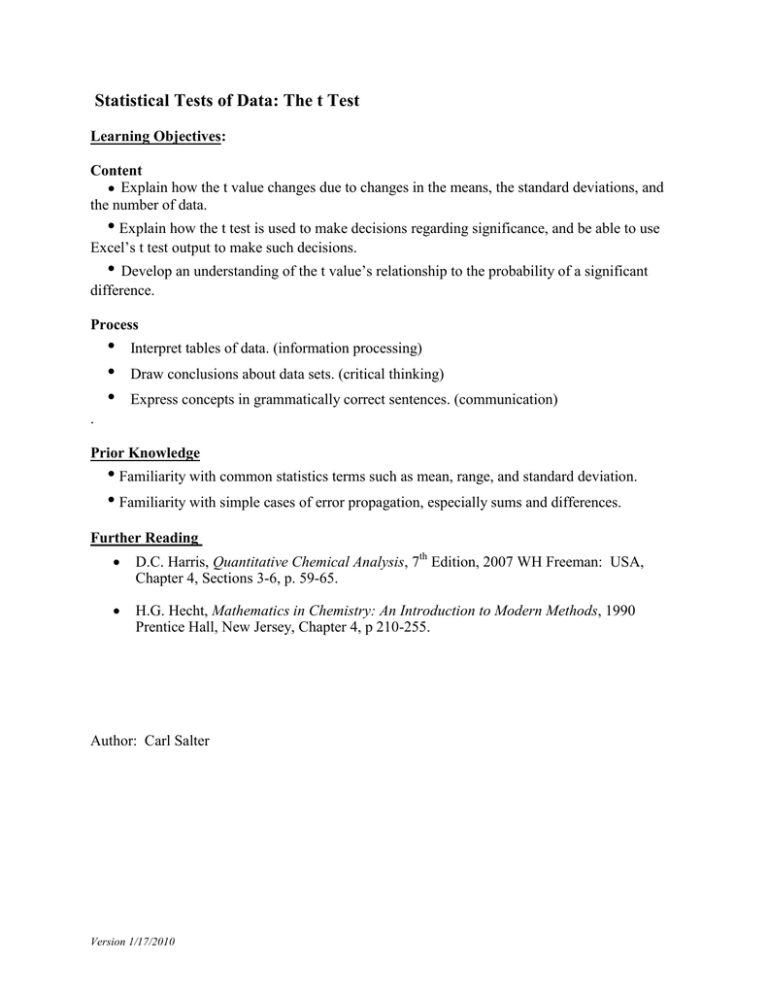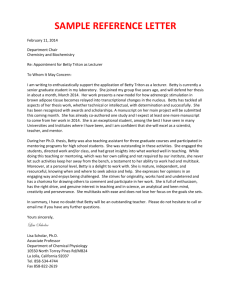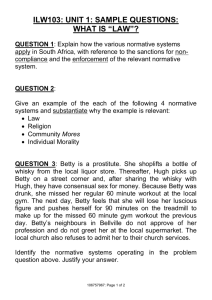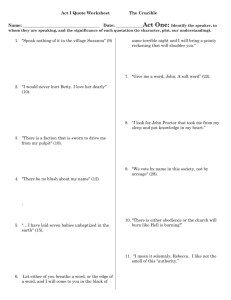Statistical Tests of Data: The t Test
advertisement

Statistical Tests of Data: The t Test Learning Objectives: Content ● Explain how the t value changes due to changes in the means, the standard deviations, and the number of data. • Explain how the t test is used to make decisions regarding significance, and be able to use Excel’s t test output to make such decisions. • Develop an understanding of the t value’s relationship to the probability of a significant difference. Process • • • Interpret tables of data. (information processing) Draw conclusions about data sets. (critical thinking) Express concepts in grammatically correct sentences. (communication) . Prior Knowledge • Familiarity with common statistics terms such as mean, range, and standard deviation. • Familiarity with simple cases of error propagation, especially sums and differences. Further Reading D.C. Harris, Quantitative Chemical Analysis, 7th Edition, 2007 WH Freeman: USA, Chapter 4, Sections 3-6, p. 59-65. H.G. Hecht, Mathematics in Chemistry: An Introduction to Modern Methods, 1990 Prentice Hall, New Jersey, Chapter 4, p 210-255. Author: Carl Salter Version 1/17/2010 Statistical Tests of Data: The t Test Scientists often compare sets of similar measurements. For example, an analytical chemist might compare two different methods for measuring the amount of carbon dioxide in air. Or a food chemist might measure dissolved carbon dioxide in two different brands of soda. Either way, we often must decide if the differences in the sets of measurements reflect real differences between the two methods or the two samples, or if the differences are not likely to be real and are probably the result of random error that is always present to some degree in any measurement. Statisticians call this significance testing. The most important statistics about a data set are its average (mean) and standard deviation; together they are called the summary statistics of the set. (Admittedly there are other important statistics about a set of data—the minimum and the maximum, for example—but it the average and the standard deviation that we subject to significance testing.) Two sets of data could differ in their average values; they could also differ in their standard deviation—either of these differences can be judged to be significant and real or insignificant and probably the result of random error. While it is never possible to say with absolute certainty whether or not a difference is real, it is possible to assign a probability. We usually label an experimental difference “significant” when its probability of “realness” is 95% or better. Significant differences deserve an explanation; differences that are not significant do not! There are two tests designed to test summary statistics: the t test tests the difference of two averages, and the F test tests the difference of two standard deviations. This activity will examine the t test. Because there are three different variations of the t test, this activity is rather long, and so it has been divided into two parts. Part 1 develops an understanding of how the t test does its job, and Part 2 examines the three different types of t tests and how they can be performed in Excel. Part 1 Fundamental Concepts Consider This April and Betty each measure the absorbance of the same colored solution three times; each student has her own absorption spectrometer. (Absorbance is unitless.) Set 1 April 0.121 0.122 0.123 Betty 0.123 0.124 0.125 Consider possible claims regarding April and Betty’s data: a. Betty’s absorption data are higher than April’s; therefore Betty’s spectrometer must somehow be different from April’s, making it give higher measurements than April’s. b. April’s absorption data are lower than Betty’s; therefore April must have somehow diluted her sample slightly before she made her measurements. c. Betty and April’s absorption data are a little different, but not by much, so maybe the difference is entirely random. Version 1/17/2010 Statistical Tests of Data 1 d. There’s no real difference between April’s and Betty’s data; the difference is within the limit of performance of the two spectrometers. 1. Which claim(s) say that the difference in April and Betty’s data is insignificant? Which claim(s) says that the difference in their data is significant and “real”? If two people claim that a difference is real, do they have to agree on the cause of the difference? Explain. 2. Are any of the claims clearly false given the available information? If your group has a unanimous opinion, explain why you think so and write an explanation. If one or more of your group believes a claim is true, would that person bet fifty dollars that the claim is true? Would anyone in your group agree to take that bet? The symbol Psignif represents the probability that the difference between April’s data and Betty’s data is significant, that is, the difference is the result of some real difference in the sample or the measuring routine. Pinsignif will represent the probability that the difference is insignificant; that is, it is due to random error. 3. Suppose that Psignif =0.85. What would be the value of Pinsignif? Explain. What is the sum of Psignif and Pinsignif, and why? Version 1/17/2010 Statistical Tests of Data 2 Consider the following possible sets of data that April and Betty might obtain. Set 1 is listed again for easy comparison. Set 1 April 0.121 0.122 0.123 Betty 0.123 0.124 0.125 Set 2 April 0.120 0.121 0.122 Set 3 Betty 0.124 0.125 0.126 April 0.121 0.122 0.123 Set 4 April 0.120 0.122 0.124 Betty 0.122 0.124 0.126 Set 5 April 0.122 0.122 0.122 Set 6 April 0.122 Betty 0.121 0.122 0.123 Betty 0.124 0.124 0.124 Set 7 Betty 0.124 April 0.121 0.121 0.122 0.122 0.123 0.123 Betty 0.123 0.123 0.124 0.124 0.125 0.125 4. Consider set 2. Compared to set 1, which summary statistics—the average, the standard deviation, or both--have changed? Compared to set 1, what has happened to the value of Psignif? Explain your conclusion. 5. Consider set 3. Compared to set 1, which summary statistics have changed? Compared to set 1, what has happened to the value of Psignif? Explain your conclusion. Version 1/17/2010 Statistical Tests of Data 3 6. Based on your answers to the previous two questions, what should happen to Psignif as the difference between the average values increases? Your answer should be a complete, grammatically correct sentence. 7. Consider set 4. Compared to set 1, which summary statistics have changed? Compared to set 1, what has happened to the value of Psignif? Explain your conclusion. 8. Consider set 5. Compared to set 1, which summary statistics have changed? Compared to set 1, what has happened to the value of Psignif? Explain your conclusion. 9. Based on your answers to the previous two questions, what should happen to Psignif as the standard deviation of the measurements increases? Your answer should be a complete, grammatically correct sentence. 10. Suppose that April and Betty had made just one measurement on the sample, as in set 6. Compared to set 1, what has happened to the value of Psignif? Explain your conclusion. 11. Suppose that April and Betty each made six measurements, as in set 7. Compared to set 1, what has happened to the value of Psignif? Explain your conclusion. 12. Based on your answers to the previous two questions, what should happen to Psignif as the number of measurements increases? Your answer should be a complete, grammatically correct sentence. Version 1/17/2010 Statistical Tests of Data 4 13. Discuss as a group: Based on the data in set 2, would you claim there is a significant difference between April and Betty’s data? Would you bet fifty dollars on that claim? 14. Based on the data in set 5, would you claim there is a significant difference between the data? Would you bet fifty dollars on that claim? 15. Develop a group summary of the effect that averages, standard deviations, and number of data have on Psignif. Version 1/17/2010 Statistical Tests of Data 5 Consider this The difference between average values of two sets of measurements is a quantity derived from the data, and as such it has an error. The error can be computed using the rules for the propagation of error. Each step in the calculation requires a corresponding step of error propagation. Step 1: Computing the averages and their errors. The standard deviation of an average value is s / n ; where s is the standard deviation of the measurements and n is the number of measurements in the set. ( s / n is sometimes called the standard error or the standard deviation in the mean. Throughout the remainder of this activity, the former name will be used.) If we have two data sets, then we get the average x1 and its error s x1 , and x 2 and its error s x2 , where Standard error: s xi si ni Step 2: Computing the difference and its error: The error in the difference of two measurements is s12 s22 , the square root of the sum of the squared errors. When we take the difference of two average values, x x1 x 2 , and the Standard error of x is s x1 x2 s x s x21 s x22 . The error in the difference of the averages is the square root of the sum of the squares of the standard errors. 16. Write the equation for sx using the original standard deviations of the measurements, s1 and s2. Simplify so that you use just one square root symbol. s x = 17. Examine the equation in Question 16. How will sx change if the standard deviations of the measurements increase? How will sx change if the number of measurements increases? 18. Relative error is the error in a quantity divided by the quantity itself. We’re interested in the relative error of the differences in the averages—well, actually we’re interested in its Version 1/17/2010 Statistical Tests of Data 6 reciprocal. Write a mathematical expression for the reciprocal of the relative error by inserting the expression for sx into the following equation: x s x Reciprocal of relative error: 19. Develop a group summary: Does the mathematical expression in Questions 18 change as you expect Psignif to change for different sets of data? Your summary should explain how the quantity will change as the standard deviations of the measurements increases, how it will change as the number of measurements increases, how will it will change as the difference of the average values increase. Consider this The quantity in Question 18 is what analytical chemists generally call the t value; t is defined as the absolute value of the difference of the means divided by the error in the difference. A t value is simply the unsigned difference divided by its error. A t value is also the reciprocal of relative error. 20. Write expressions for the t value, first using the standard errors, and then using the standard deviations in the measurements. t x s x x1 x 2 x1 x 2 Why do we use the absolute value? Why can we disregard the sign of the difference? Version 1/17/2010 Statistical Tests of Data 7 21. As a group, verify that for every set of April and Betty’s data, n1 = n2 and s1 = s2. Write an equation for t given these special conditions. Since they are equal, use s and n without subscripts in this special formula. 22. Using the formula you derived in Question 21, fill in the following table for each set of data. Divide up the work among the members of your group. Set 1 x1 x 2 0.002 s n 0.001 t 3 2.449 Unknown 1 NA 0.0009 6 3.873 2 3 4 0.002 5 6 7 0.002 There are two cases where it is not possible to compute t. What problems prevent you from computing t? 23. Discuss as a group: Does t change as you expected Psignif to change in these data sets? Do t and Psignif have the same trend as the data changes? Give two examples supporting your answer and explain your reasoning. 24. Discuss as a group: What is the range of possible numeric values for t? (That is, what values could it take on?) Version 1/17/2010 Statistical Tests of Data 8 What is the range of possible numeric values for Psignif? Could t be the same numerical quantity as Psignif? Explain why or why not. Version 1/17/2010 Statistical Tests of Data 9 Consider this It is possible to use the t value to determine Psignif -- but right now all we need to do is find out if Psignif ≥ 0.95. There is a table of t values that tells us when t is big enough to know that Psignif ≥ 0.95. The table is given below. It is a portion of the Student’s t table for two-tailed distributions. (Excel’s TINV function will provide these values.) Degrees of tcritical for freedom Psig ≥0.95 1 12.706 2 4.303 3 3.182 4 2.776 5 2.571 6 2.447 7 2.365 8 2.306 9 2.262 10 2.228 15 2.131 20 2.086 25 2.060 30 2.042 40 2.021 50 2.009 60 2.000 120 1.980 ∞ 1.960 When you compare a t value for experimental data against a tcritical value, you are doing a t test. In different books the t value computed from the data may be called tcalculated or tcalc or tdata or tstat or simply t; the t value from the Student’s t table is usually called tcritcal or ttable. There are several types of t tests, but in all cases when tcalculated > tcritical, the difference being tested is considered significant. For the rest of Part 1 of this activity, and also in Part 2, we will use the symbols tcalc and tcrit. tcalc is computed from the data; tcrit comes from the table. When the tcalc > tcrit, we know that Psignif >0.95, and we can conclude that the difference in the means is real and significant. 25. What would we conclude about Psignif if tcalc equaled tcrit? 26. To find a particular tcrit value in the Student’s t table, what quantity do you need? Version 1/17/2010 Statistical Tests of Data 10 The number of degrees of freedom is the total number of data minus the number of averages that were computed from the data. ndf n p Degrees of freedom: where p is the number of averages that were computed. 27. If April and Betty have each collected 3 data, and they each compute 1 average value from their data, they each have 2 degrees of freedom. What is the total degrees of freedom from both sets of data? How many degrees of freedom are there when April and Betty each collect 6 data? 28. Complete the following table for each set of data. Enter t from your previous table as tcalc. Divide the work among the members of your group. Set 1 n tcalc 3 ndf tcrit Significant ? no 2.228 YES! 2.449 2 4 3 4 5 6 1 NA 7 6 3.873 0 29. Discuss in your group: Among the five cases where it was possible to compare tcalc and tcrit, which ones showed a significant difference? Are there any cases where you and your group are surprised that the Psignif is greater than 0.95? 30. Which set appears to have the most significant difference? What makes you think that it is most significant? What is it about this data set that leads to this result? Would you or anyone in your group bet fifty dollars that this difference is significant? Version 1/17/2010 Statistical Tests of Data 11 31. What question does the t test answer? 32. For group discussion: How confident are you that you understand how the t test is used? 33. As a group, describe your ability to read statistical tables. Version 1/17/2010 Statistical Tests of Data 12 Applications 34. Consider the two cases where a t test could not be completed. How are the two cases different? Based on the behavior of tcrit in the Student’s t table, what conclusions can you draw about the significance of the differences in these two cases. 35. Consider set 1. Generate a set of three data that is significantly different from April’s data but not significantly different from Betty’s data. 36. Suppose you had two data sets each containing four data, and the two sets have equal standard errors. How far apart would the two means have to be, in terms of the standard error, for the t test to yield a significant difference? 37. Blood is drawn from a patient suffering from hypoparathyroidism to determine her serum calcium concentration. Five replicate analyses yield a mean of 8.11 mg/dL with a standard error of 0.16 mg/dL. Two weeks later after drug therapy her serum calcium is measured again; now five measurements yield 8.40 mg/dL with a standard error of 0.19 mg/dL. Has the patient’s serum calcium changed? 38. Sally measures the amount of CO2 in a pint soda bottle by weight loss; she shakes the bottle vigorously and then slowly opens the cap, letting the gas escape. Three measurements on Brand X indicate a loss of 2.2 ± 0.2 g of gas, while three measurements on Brand Y shows a loss 2.4 ± 0.3 g. (The ± indicates standard error.) Do Brands X and Y have different amount of CO2? 39. Suppose that Bob and Bill make repeated measurements of the amount of iron in two iron ore samples. Bob gets 20.14%, 20.14%, 20.20%, and 20.26% Fe for his ore sample, and Bill gets 20.02%, 20.08%, 20.11% , and 20.18% Fe for his sample. Do the two samples have different iron percentages? Version 1/17/2010 Statistical Tests of Data 13 Part 2 Excel Implementation and Variations The t test that we have been considering is called a Comparison of Two Means, or a Comparison of Replicate Measurements. This test tells us if x , the difference in the average value of two sets of measurements, is statistically significant. Review: In Part 1 we learned that the value tcalc is the ratio of the difference of the means to the standard error in that difference. x t calc s x As tcalc increases, the probability of a significant difference increases. We saw that tcalc increases with increasing difference in the means, increasing numbers of data, and decreasing standard deviations. To do a t test, tcalc is compared with tcrit, a value that is selected from the Student’s t table based on the number of degrees of freedom ndf. If tcalc > tcrit, then the probability of a significant difference, Psignif , is greater than 0.95 and the difference is considered significant. Consider this In the examples we examined in Part 1, April and Betty always had the same number of data, and the standard deviations of their measurements were always equal. Clearly this will not always be the case. In set 2 below April and Betty have different numbers of data and different standard deviations. The mean and variance are listed for each group of data. (The variance ν is the square of the standard deviation.) April 0.121 0.122 0.123 x ν 0.122 Set 1 Betty 0.123 0.124 0.125 10x10-07 0124 10x10-07 Set 2 April Betty 0.121 0.123 0.122 0.123 0.123 0.124 0.124 0.125 0.125 0.122 0.124 10x10-07 8x10-07 Set 3 April Betty 0.121 0.123 0.121 0.123 0.122 0.124 0.122 0.124 0.123 0.125 0.123 0.125 0.122 0.124 8x10-07 8x10-07 1. Consider tcalc for each of these data sets. Rank the sets in the order that you expect tcalc to fall, from lowest to highest, and explain your prediction. 2. Test your predicted order. For each set of data, compute tcalc. Version 1/17/2010 Statistical Tests of Data 14 t calc Comparison of Two Means x s x x1 x2 s12 s 22 n1 n2 Divide the work among your group. Was your predicted order correct? 3. Determine tcrit for set 2. Is the difference between April’s and Betty’s means significant in this case? Here are the results of a t test performed on Set 2 in Excel using the t-test: Two-Sample Assuming Equal Variances tool in the Data Analysis Toolpak. The default values of the test were used. Mean Variance Observations Pooled Variance Hypothesized Mean Difference Df t Stat P(T<=t) one-tail t Critical one-tail P(T<=t) two-tail t Critical two-tail April 0.122 0.000001 3 8.57E-07 Betty 0.124 8E-07 6 0 7 -3.05505 0.009226 1.894579 0.018452 2.364624 *This Excel test reports a negative value of t. In Excel input window, if the columns containing April and Betty’s data are swapped, the t test tool will report a t Stat equal to +3.055. For this type of t test, ignore a negative sign in a t value from Excel! 4. As a group, examine the t test results from Excel. Based solely on the Excel results, is the difference between April’s and Betty’s means significant? Which values in the output did you use to make your decision? Version 1/17/2010 Statistical Tests of Data 15 Here are the essential test results from Excel for all three sets. Pooled Variance df t Stat P(T<=t) two-tail t Critical two-tail Set 1 0.000001 4 2.44949 0.070484 2.776445 Set 2 8.57E-07 7 3.05505 0.018452 2.364624 Set 3 8E-07 10 3.87298 0.003094 2.228139 5. Compare the results from Excel with your results in Questions 2 and 3. Check tcalc, ndf, and tcrit. Can you assign these values to the Excel output? Are there any values that disagree with your results? You should find that your value of tcalc for set 2 is slightly less than the “t Stat” value from Excel (though it doesn’t affect the decision that the means are significantly different.) However, your tcalc for sets 1 and 3 agree with Excel! 6. Compare the quantities labeled Pooled Variance with the variances listed for each group of data. What conclusion can you draw about the value of the pooled variance when the individual variances are equal? The pooled standard deviation is a way to combine standard deviations for two sets of measurements if the variances are essentially equal. It simplifies the formula for the standard error of the difference. s pooled (n1 1) s12 (n2 1) s 22 n1 n2 2 The pooled variance is pooled s 2pooled Using the pooled standard deviation, we can express s x more simply: s x s pooled 1 1 n1 n2 Version 1/17/2010 Statistical Tests of Data 16 8. Show that, using the pooled standard deviation, the formula for tcalc becomes x1 x2 n1 n2 when the variances are roughly equal. t calc s pooled n1 n2 9. The t test used in Excel made the assumption that the variances of the two sets of data were equal. Are the two variances in Set 2 equal? In another activity we will introduce a test called the F test that will determine if the variances are significantly different. There are actually two forms of the t test, and the choice of t test is based on the result of the F test. If the variances are not significantly different, then t is computed using the formula in Question 8 using spooled. If the variances are significantly different, then spooled is not used, and tcalc is computed using the formula in Question 2. But there are other differences as well; these will be covered in the F test activity. In theory, we should always do an F test before we do the t test--but in practice the F test is often skipped. In routine chemical analysis on small data sets that come from the same measuring device, it is reasonable to assume that the variances are not significantly different, even if they are not exactly equal. But it is always safer to test that assumption than to proceed in error! 10. In the Excel output, there is a quantity labeled P(T<=t) two-tail. This quantity is a probability. Is it Psignif or Pinsignif? Explain your choice. * One of the default values for the t test is “alpha=0.05”. “Alpha” is Pinsignif; alpha = 0.05 makes the t test use a tcrit consistent with a 95% probability of a real difference. Statisticians usually based their tables on Pinsignif, so be careful when you are looking at P values--If you see an α, assume the α probabilities are Pinsignif. 11. For group discussion: If you had to bet fifty dollars on something, what would be the better bet: that the difference in set 2 is real, or that you will draw one card from a standard pack of 52 cards and not draw a deuce? Explain. Version 1/17/2010 Statistical Tests of Data 17 12. As a group, write a set of instructions that would let a lab technician read the output of an Excel t test and come to a conclusion about significance. Consider this The most common type of t test is the Comparison of Means, but there are two other important applications of the t test. Both can be considered special cases of the Comparison of Means. The first is the Comparison Against an Accepted Value. Often we want to compare one set of measurements against a value that is “known” or accepted as “true”. The true value is widely regarded as “above reproach” and can be assumed to have no error. 13. For group discussion: If the accepted value has no error, what is its “standard deviation”? 14. Assuming that x 2 = True and sT rue = 0, show that the formula for tcalc for the Comparison Against an Accepted Value becomes x1 True x1 True t calc n1 or simply s x1 s1 Comparison Against Accepted Value t calc x True s n 15. April and Betty are told that the accepted value for the absorption of their solution is 0.122. Using the data in set 2, determine whether April and Betty’s average values are significantly different from 0.122. Version 1/17/2010 Statistical Tests of Data 18 Consider this Another type of t test is the Comparison of Paired Values or Comparison of Individual Differences. It is used to test the significance of a series of differences that result from paired measurements on the same sample. Suppose that April and Betty get six different colored solutions and measure the absorptions of the solutions using their instruments. They now have six pairs of measurements, and they can compute six differences, one difference for each pair: d1=ABetty1-AApril1, d2=AB2AA2, d3, d4, d5, and d6. From these values of d they compute the average difference d , and sd, the standard deviation of the differences. 16. For group discussion: April and Betty hope that their measurements agree. What values would they like to get for d and sd? 17. Realistically, since there is always some random error present in any measurement, April and Betty will not get sd=0. If their measurements mostly agree, should d >sd or should d <sd? Explain your group’s reasoning. 18. April and Betty need to test d to see if it is significantly different than 0. (Even though they’re hoping that it won’t be!) Show that if x = d and True=0, the formula for tcalc for the Comparison of Paired Values becomes t calc d sd or simply Comparison of Paired Values t calc d sd n 19. Since April and Betty are testing an average based on six values (even though there were originally twelve measurements), for their paired t test, n=6. So what is ndf? Version 1/17/2010 Statistical Tests of Data 19 20. Assume that April and Betty get identical measurements for three solutions and get a difference of +0.001 for the other three. (Betty’s values are always higher.) Generate a set of data consistent with the assumption. Obviously d =+0.0005. Find sd. Is it > or < d ? Compute tcalc. Find tcrit. Are April and Betty getting significantly different measurements? Explain your conclusion in a complete sentence. 21. Most Student’s t tables have columns of tcrit values for other values of Psignif. Usually these probabilities are called “confidence levels” and are given in percentages. For example, for 5 degrees of freedom, you would find the following values: ndf 50% 90% 95% 98% 99% 99.5% 99.9% 5 0.727 2.015 2.571 3.365 4.032 4.773 6.869 Based on the tcrit values for ndf=5 and the tcalc you computed in Question 20, bracket the value of Psignif: _________< Psignif < _________ Version 1/17/2010 Statistical Tests of Data 20 22. Here is the output from Excel’s Data Analysis ToolPak for a t test: Paired Two Sample for Means. The input data was consistent with Question 20. Mean Variance Observations Pearson Correlation Hypothesized Mean Difference df t Stat P(T<=t) one-tail t Critical one-tail P(T<=t) two-tail t Critical two-tail April 0.158 0.017432 6 0.999992 Betty 0.1585 0.01745 6 0 5 -2.23607 0.037793 2.015049 0.075587 2.570578 Since April’s data are always less than or equal to Betty’s and April’s data were placed in the first column, the value of t Stat is negative. Otherwise, is it consistent with your value of tcalc? Explain. What other values do you recognize in the Excel output? Do they match your values? 23. Excel reports that P(T<=t) two-tail is 0.076. What does this indicate about Psignif and Pinsignif? Is it consistent with your conclusion about Psignif in Question 21? 24. As a group, review your set of instructions for a lab technician in Question 12. Would they work for the Paired Two-Sample t test? If not, modify them accordingly and write them below. 25. What are the three types of t tests, and what questions do they answer? Version 1/17/2010 Statistical Tests of Data 21 26. For group discussion: How confident are you that you will know which t test to use in a given situation? 27. As a group, describe your ability to read Excel output. Version 1/17/2010 Statistical Tests of Data 22 Applications 28. Insert the data from Set 2 into Excel and verify that you get the Excel output shown in Question 3. 29. Suppose you had a set of four data with a certain mean and standard error. Suppose there is an accepted value for these data. In terms of the standard error, how far away from the accepted value would the mean have to be for the t test to determine a significant difference? 30. Suppose that Bob and Bill make repeated measurements of the amount of iron in two iron ore samples. Bob gets 20.14%, 20.14%, 20.20%, and 20.26% Fe for his ore sample, and Bill gets 20.02%, 20.08%, 20.11% , and 20.18% Fe for his sample. Bob and Bill learn that their samples are from the same source, and that the accepted value is 20.09% Fe. Are Bob’s and Bill’s means significantly different from the accepted value? 31. Suppose you have a set of seven paired samples with an average difference of d and a standard error in the difference of s d . In terms of the standard error, how big must d be for the paired t test to determine a significant difference? 32. Insert the data you generated in Question 20 into Excel, perform the Paired Two-Sample t test, and show that you get the results displayed in Question 22. 33. Eight patients are treated for hypoparathyroidism using a drug therapy. Before the treatment, the eight patients have serum calcium levels of 8.12, 7.98, 8.06, 7.65, 8.20, 8.08, 8.15, and 8.22 mg/dL. After treatment, the serum levels were 8.22, 8.02, 8.08, 7.96, 8.31, 8.28, 8.20, and 8.33 mg/dL. Was there a significant increase in serum calcium after the patients were given the treatment? Which t test should be used to answer this question? Version 1/17/2010 Statistical Tests of Data 23







